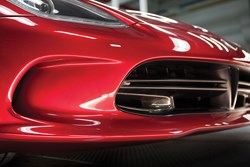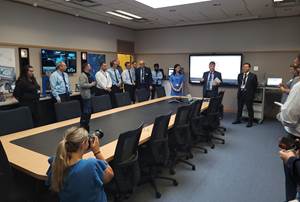Carbon Fiber 2013 report, part 2: Automotive
Carbon fiber's future in automotive applications is not a sure thing, but the potential is real.

One of the bigger topics of interest at CompositesWorld's Carbon Fiber conference, Dec. 9-12 in Knoxville, Tenn., USA, was automotive composites. Two presentations hit this topic pretty hard.
First: “Emerging Opportunities and Challenges for Carbon Fiber in Passenger Automobiles: Is the CFRP industry ready for mass production?” was the title of Chris Red’s three-hour pre-conference seminar, where attendees caught Red’s predictions of automotive carbon fiber. Red, who heads Composites Forecasts and Consulting LLC (Mesa, Ariz., USA), identified 104 car models that feature OEM-specified carbon fiber composites to some degree, despite his figure of $19.10/lb ($42/kg) material cost for carbon — steel is $0.66/lb ($1.46/kg). In his view: “We can’t get into mid- and high-volume model production scenarios within the next 10 years,” due to high price and processing issues. That said, legislation mandating reductions in greenhouse gas emissions is a powerful driver for OEMs, who must dramatically improve fuel efficiency, as well as end of life recycling goals, over the next 10 years. Red believes that mid- to full-size luxury cars, luxury sports cars and some SUVs and CUVs hold the most promise for carbon composites adoption. The automotive industry today represents about 6 percent of total carbon fiber demand.
Red asserts there are good opportunities for carbon fiber composites in suspension components such as chassis frames, powertrain elements, brakes and wheels, beyond exterior body panels. Of all the OEMs examined, BMW (Munich, Germany) and the Volkswagen Group (Wolfsburg, Germany) are the biggest users of carbon fiber at present. A joint venture between Brembo SpA (Curno, Italy) and SGL Group (Wiesbaden, Germany) is one of the largest single users of carbon fiber materials, and occupy a dominant market share. Not surprisingly, 70 percent of carbon fiber composite part suppliers are located in Europe, the largest including ITCA Colonnella SpA (Colonnella, Italy), Sotira (Meslay du Maine, France) and Mubea Carbo Tech Composites GmbH (Salzburg, Germany). Some North American firms made his “biggest” composites supplier list, including Morrison Molded Fiberglass Co. (Ashtabula, Ohio), Multimatic Inc. (Markham, Ontario, Canada) and Plasan Carbon Composites (Bennington, Vermont and Walker, Mich.). Red concluded that, despite a drop in carbon fiber usage in automotive of nearly 50 percent between 2005 and 2010, over the next 10 years, without a speculative demand add-on, the identified vehicle population is expected to consume more than 173 million lbs/78.6 million kgs of carbon fiber. “Outside of wind energy, the automobile represents the biggest growth opportunity for carbon fiber market growth and penetration,” he says.
Many eyebrows were raised at the conference by Patrick Blanchard, technical leader, Composites Group at Ford Motor Co. Research & Advanced Engineering, who addressed emerging CAFE standards and lightweighting efforts at the carmaker. He reminded the audience that CAFE targets progress annually and require 3.5 percent fuel efficiency improvements year over year through 2025. He also noted that Ford research shows that consumers are not concerned about vehicle weight. They are most concerned with vehicle handling, braking and safety, and although vehicle weight affects these things, weight by itself is not important. Finally, he reported that powertrain advances involving hybrid and electric technologies will allow a company like Ford to meet CAFE targets; reducing vehicle weight will extend the range of high-efficiency cars, but weight elimination is not necessary to increase efficiency. That said, weight is an issue. New customer features in cars and trucks, since 1998, have added 17 lb/year to each new car model and 43 lb/year to each new truck model. Ford, Blanchard noted, is looking at aluminum and lightweight steel to help trim mass. These "legacy" materials fit best with Ford's manufacturing systems, which of course favor metals. Carbon fiber, he noted, needs to meet these requirements: be scalable, improve design and CAE tools, develop robust repair technologies, prove adequate supply, and prove compatibility with vehicle painting processes. Blanchard did not mention carbon fiber price as a hurdle, but in question and answer following his presentation he said that he left price out of his presenation because Ford infrasctructure requirements present bigger hurdles to the material. Blanchard said Ford has 39 assembly plants globally, producing 7 million vehicles a year. Reconfiguring those plants to accommodate carbon fiber manufacture would be prohibitively expensive. Blanchard did say that he thinks composites use in automotive has a future, particularly in multimaterial applications, but made clear that carbon fiber use at Ford is not a forgone conclusion.
Ford, when speaking to composites audiences in the past, usually will argue that carbon fiber's expense is a show-stopper, and that if the price comes down, the material will be used more. Blanchard, however, made it clear that carbon fiber cost, ultimately, may have little impact on the material's use at Ford. It also bears noting that Ford is working closely with Dow on development of a carbon fiber made with a non-PAN precursor. Ostensibly, this will lead to less expensive carbon fiber and boost its use in the automotive industry. Clearly there is much dust yet to settle in the carmaking and carbon fiber supply communities.
Related Content
SolidCAM Wants to Help Machine Shops Get into Additive Manufacturing
SolidCAM's partnership with Desktop Metal is aimed at making additive manufacturing more accessible to job shops and other manufacturers.
Read More4 Tips for Staying Profitable in the Face of Change
After more than 40 years in business, this shop has learned how to adapt to stay profitable.
Read More4 Steps to a Cobot Culture: How Thyssenkrupp Bilstein Has Answered Staffing Shortages With Economical Automation
Safe, economical automation using collaborative robots can transform a manufacturing facility and overcome staffing shortfalls, but it takes additional investment and a systemized approach to automation in order to realize this change.
Read MoreMarposs Celebrates its Past, Eyes Future Opportunities
During its open house in Auburn Hills, Michigan, Marposs presentations focused on future opportunities across growing industries such as EV and semiconductors.
Read MoreRead Next
The Cut Scene: The Finer Details of Large-Format Machining
Small details and features can have an outsized impact on large parts, such as Barbco’s collapsible utility drill head.
Read More3 Mistakes That Cause CNC Programs to Fail
Despite enhancements to manufacturing technology, there are still issues today that can cause programs to fail. These failures can cause lost time, scrapped parts, damaged machines and even injured operators.
Read More


























